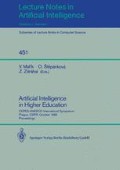Abstract
Results are summarized from current research projects that explore ways in which Artificial Intelligence models and tools can be incorporated to use the computer more effectively as a teaching aid. In particular the Information Resource Model was designed as a database especially for education. The heart of the model is a graphical query language which achieves hypertext behavior while ameliorating some of the shortcomings of hypertext.
Preview
Unable to display preview. Download preview PDF.
References
Aiken, R. M., "Great Expectations", Invited Paper, to be published in Proceedings of IFIP Working Conference, on Educational Software at the Secondary Education Level", North-Holland, 1989.
Buneman, P., Frankel, R., & Nikhil, R. (1982) "An Implementation Technique for Database Query Languages", ACM Transactions on Database Systems 7(2), pp. 164–186.
Conklin, J. (1987) "Hypertext: An Introduction and Survey", IEEE COMPUTER, 20(9), pp. 17–41.
Epstein, R. G. (1987) "Informatics Calculus: A Graphical, Functional Query Language for Information Resource Systems", doctoral dissertation, Department of Computer and Information Sciences, Temple University.
Epstein, R. G. and Aiken, R. M., "The Information Resource Model", Proceedings of "International Conference on Computer Assisted Learning", (ICCAL '89), published by Springer-Verlag, pp. 77–101.
Epstein, R. G, "Tabletalk: A Graphical Query Language" submitted for publication, 1989.
Kirsch, R., Personal Communication, October, 1989.
Shipman, D. (1981) "The Functional Data Model and the Data Language DAPLEX", Acm Transactions on Database Systems, 6(1), pp. 140–173.
Wenger, E., ARTIFICIAL INTELLIGENCE AND TUTORING SYSTEMS: Computational and Cognitive Approaches to the Communication of Knowledge, Morgan Kaufmann Pub. Inc., 95 First St., Los Altos, CA, 94022, 1987.
"Where in the World is Carmen Sandiego", Broderbund, 1985.
"The Writer Rabbit", The Learning Company, 1985.
Zloof, M. M. (1977) "Query-by-Example: A Data Base Language", IBM Systems Journal, 16(4).
Author information
Authors and Affiliations
Editor information
Rights and permissions
Copyright information
© 1990 Springer-Verlag Berlin Heidelberg
About this paper
Cite this paper
Aiken, R.M. (1990). The impact of artificial intelligence on education: Opening new windows. In: Mařík, V., Štěpánková, O., Zdráhal, Z. (eds) Artificial Intelligence in Higher Education. Lecture Notes in Computer Science, vol 451. Springer, Berlin, Heidelberg. https://doi.org/10.1007/3-540-52952-7_1
Download citation
DOI: https://doi.org/10.1007/3-540-52952-7_1
Published:
Publisher Name: Springer, Berlin, Heidelberg
Print ISBN: 978-3-540-52952-1
Online ISBN: 978-3-540-47183-7
eBook Packages: Springer Book Archive

